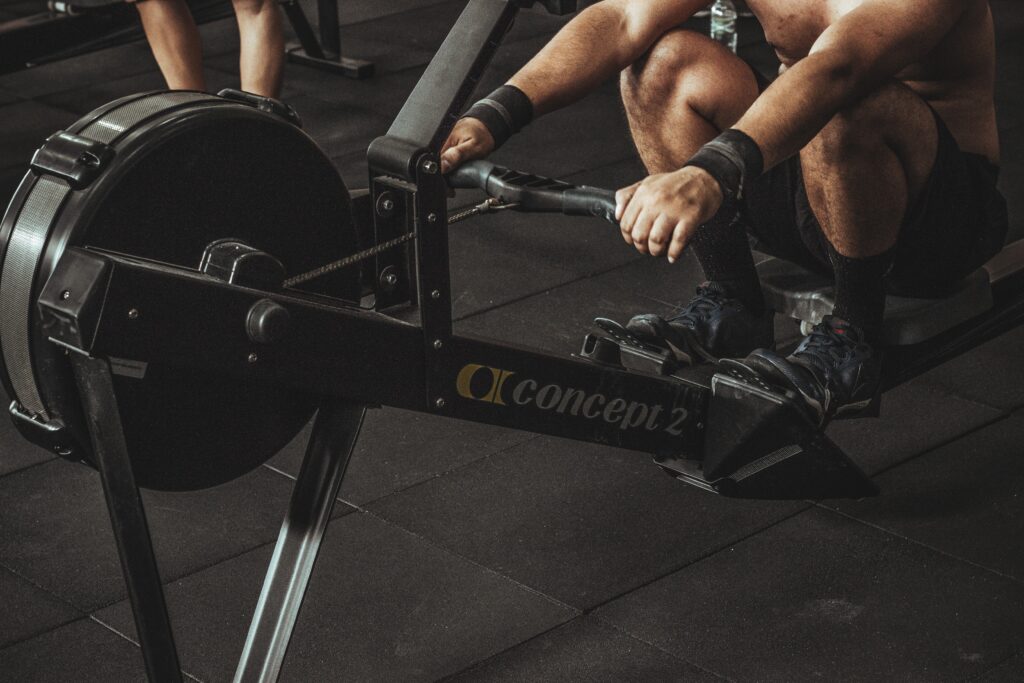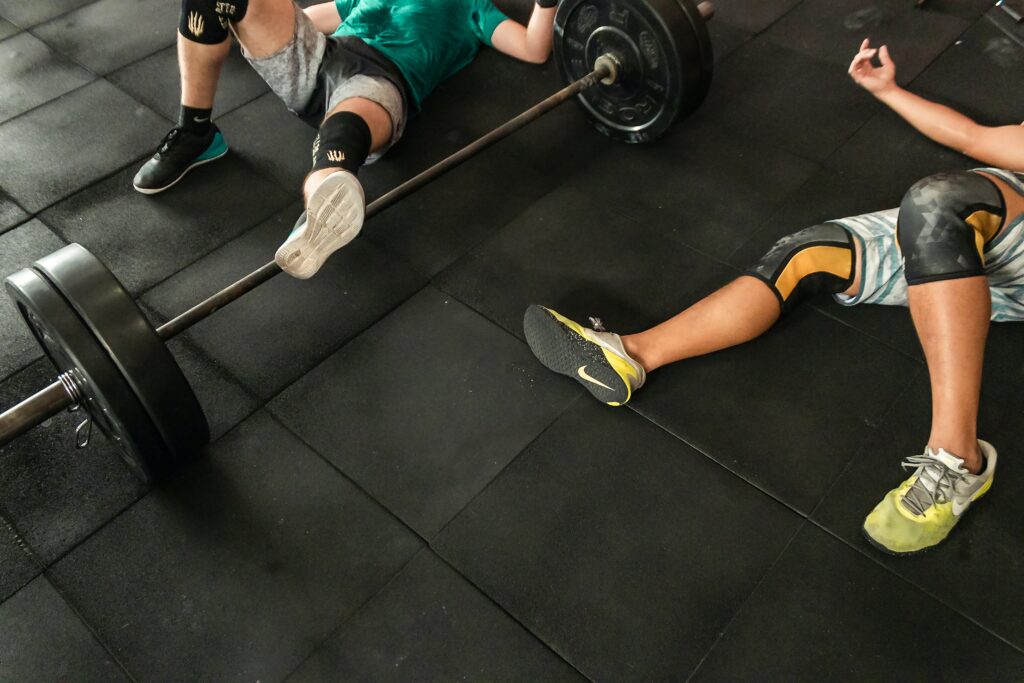
Sometimes, the very word ‘cardio’ creates a fight or flight response in lifters. They hear it, or read it, and see in their mind someone joylessly trudging through a 45-minute commercial gym, treadmill workout at a plodding pace. Let’s call it ‘The New Year’s Resolutioner’ workout.
But it doesn’t have to be this way.
Cardio is a vitally important part of your gym diet, and the fact is that too many of us – myself included – have been sleeping on it for too long.
We see the tedium and agony of the treadmill pounders and the stair-climbers and we think “No! Not for me!”
But it doesn’t have to be this way.
In this article I am going to give you two ways that you can make cardio something you look forward to rather than actively avoid.
One is a more traditional equipment-based workout using the ski erg, the rower and the bike, and one is what I term ‘cardio for meatheads’: fun, barbell-focused sessions that will give you a quick pump as well as a thorough conditioning workout.
Interested? Then read on.
Why do we need to do cardio?
Cardio for weight-loss is not a very smart idea. Or, rather, cardio solely for weight-loss is not a very smart idea. If you base your attempts to lose weight purely on 45 minute of boring repetition three times a week, you will most likely fail in those attempts. However good your intentions, you won’t want to do it after a while.
Dreading the gym is the number one way to avoid it!
However, cardio is vitally important. Firstly, your heart is a muscle just like your hamstrings or your biceps. We need to work this muscle regularly and strategically to allow to remain healthy.
The big difference between your heart and your hamstrings or biceps is … well, let’s just say that you can live reasonably comfortably without your hamstrings or your biceps. If your heart goes, then so do you.
Secondly, regular and repeated aerobic training works to make you fitter. Being fit – the ability for your body to deal with stresses and recover quickly – can only be a positive thing. It has unending benefits for your blood pressure, your respiratory rate and your resting heart rate. All of these things are important, and you should bear them all in mind as you get older.
The third reason that lifters should not neglect their cardio is because it will actually help you get stronger and build more muscle.
As our fitness increases, our recovery time shortens, and this leads to being able to get more done. Let’s say you are a very unfit ‘powerlifter’ (we see you, waddling across the gym with your gallon water jug and three protein bars). You do a very taxing deadlift workout on Monday. Chances are, it will be the following Monday, or maybe even later, before your body has fully recovered from the strain placed on it by that deadlift workout.
Now let’s say you are a lifter who does cardio 2/3 times per week. You do a deadlift workout on the same day, and at the same relative intensity. It is highly likely that you will be recovered sooner, and therefore can do another high intensity deadlift workout before the ‘unfit’ guy.
Over the course of a year, the fitter athlete is going to get more quality exercise, more quality recovery, and more quality muscle growth than his imaginary unfit counterpart.
TL;DR? Do your cardio! Let’s look at how.
Workout 1 – 30 minutes of ‘bang for your buck’.
For this workout, all you are going to need is two or three different ‘stations’ – these can be absolutely anything that gives you an aerobic workout. I will be walking you through this workout using the Ski Erg, the Concept 2 Rower and the dynamic bike, but feel free to substitute with anything that you have: ball slams, burpees, hill sprints, sandbag carries – even squats if you’re feeling particularly crazy (but I wouldn’t recommend it!)
We are going to divide our time into nice “easy” portions. Three lots of 6 minutes. Three lots of 3 minutes. Three lots of 90 seconds. You will notice that the time of each portion halves. More on this later.
After warming up, you’re going to choose your first station and you’re going to do 6 minutes of work on it. It really is that simple. If you have a wearable fitness watch, then think about staying around 140bpm, if you don’t then treat these 6 minutes as some moderate intensity where you’re going to get moderately out of breath; 6 or 7 out of 10 for effort.
Then – 1 minute rest, switch to the next station and do the same. After that, one more minute’s rest and then final 6 minutes on the final station. This is the first round done.
After this, we enter the ‘three minutes’ round. Work through the machines in the same order, and with the same rest. You are going to use a higher intensity here, 7 or 8 out of 10 for effort. You should be feeling very ‘worked out’ after this round.
The final round will be 90 seconds of high intensity. Somewhere between 8 -10 out of 10 depending on how you’re feeling. It is “only” 90 seconds, so you are going to go all out here.
In summary, it should look something like this:
| Round 1: 60-70% intensity | Round 2: 70-80% intensity | Round 3: 80 – 100% intensity |
|---|---|---|
| A) Ski Erg – 6 minutes | A) Ski Erg – 3 minutes | A) Ski Erg – 90 seconds |
| 1 minute rest | 1 minute rest | 1 minute rest |
| B) Rower – 6 minutes | B) Rower – 3 minutes | B) Rower – 90 seconds |
| 1 minute rest | 1 minute rest | 1 minute rest |
| C) Bike – 6 minutes | C) Bike – 3 minutes | C) Bike – 90 seconds |
| 1 minute rest | 1 minute rest | FINISH |
That will be one hell of a workout, if you need it to be. You can also use exactly the same protocols as a recovery workout if you just need to move and get the blood pumping. Keep the relative intensities low and you’ll be on your way to healthful recovery.
To scale this, you can play around with the timings of each round, the kit you use or the rest periods. It really is endlessly adaptable.
Personally, I keep note of the distance covered in each section and the calories burnt (this is a largely unreliable measurement but it does give you something to compare with each time you do it)
Play around with it, customize it, and have fun – that’s supposed to be the point of physical exercise, isn’t it?
Workout 2 – Barbell lungbuster

Workout 1 was a traditional ‘cardio’ aerobic workout. Workout 2 is for those who begin to feel separation anxiety if they don’t have a barbell in their hands every time they enter the gym.
This workout will kick your backside if you are not careful, so demonstrate extreme caution!
We are going to be dividing the workout into three portions again – each portion is 8 minutes and you are going to achieve as many reps as possible within those 8 minutes (AMRAP)
We are going to use big barbell movements here for singles. The bigger the better; we don’t want fidgety movements that take a lot of setting up, so for that reason the snatch and clean are out, although we can use the power snatch and power clean if you’re technically proficient in those lifts.
We also want lifts that complement each other – so a push and a pull, a hinge and a row, a squat and a push all work nicely.
The workout itself looks like this:
| Section A – 8 Minutes | Section B – 8 minutes | Section C – 8 minutes |
|---|---|---|
| A) Bench Press x 1 @ 50% of 1RM | Dumbbell Manmakers (1 press up / 1 Renegade Row / 1 burpee / 1 curl / 1 shoulder press / 1 lunge) Or Bike/rower/ski for 8 mins | A) Deadlift x 1 @ 50% of 1RM |
| B) Squat x 1 @ 50% of 1RM | B) Push Press x 1 @ 50% of 1RM |
Simple, eh? You are going to alternate between singles on two big movements, constantly for 8 minutes. No rest. No breaks. Just single, move, single, move, single etc. etc. You may be using barbells but make no mistake, there will be lots of cardio here – give yourself 2 minutes break between the sections. You’ll need it!
The weights are set at 50% of 1RM for a reason, don’t go above this. From my experience even 60% is too much load.
Just like the first workout, it is endlessly adaptable. Play around with what works for you. I’ve known people use power cleans and burpees as a pairing, also dumbbell bench and RDLs, deadlifts and box jumps, pull-ups and rows. Work out what you like and what feels good, and then have some fun.
Do two cardio workouts a week, as a minimum, and you’re good to go.
Conclusion
Cardio is not high on everyone’s list – no-one is saying that you have to love it, but it should be higher. By getting regular aerobic workouts, you’re giving yourself the best investment possible. A strong heart and powerful lungs will be useful long after your beach muscles have faded.
Try the two cardio workouts I have outlined for you here. They’re relatively short, rather brutal and really effective. Find what works for you and customize it. Just don’t skimp on heart day.
Don’t hesitate to email us at [email protected] for personalized coaching and a client questionnaire if you’d like DEDICATED tailor-made personal training on strength training, building muscle, losing fat, developing athleticism, and more — all to your liking, lifestyle, habits, and taste!
Otherwise, don’t forget to claim your FREE eBook detailing how to lose 20lb of fat while building muscle in 12 weeks! You can claim it here.
Alternatively, you can pick up a FREE eBook on fundamental strength principles offering an introductory workout program.











